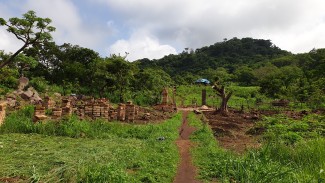Originally published in OECD Development Matters.
The median recovery time of least developed countries (LDCs) from the economic impact of the COVID-19 pandemic is three years, according to the International Monetary Fund. More worryingly, more than a dozen of them are likely to take at least five years to recover.
As the recently released Least Developed Countries Report 2021 shows, trade can be a powerful tool to help LDCs accelerate their recovery by taking advantage of the rapid rebound seen in other parts of the global economy. However, for this to happen, LDCs need aid for trade to build their institutional and productive capacity. This has been very well recognised by LDCs; on 19 October 2021, trade ministers from almost 30 LDCs adopted a declaration outlining their priorities for aid for trade.
For the past ten years, the global share of LDC trade has hovered at around 1%, despite the target to double their share of global exports by 2020 as set out in the Istanbul Programme of Action for LDCs and SDG 17.11. The fifth United Nations Conference on LDC (UNLDC 5) in Doha in January 2022, where a programme of action for the coming decade is expected to be adopted, is an important opportunity for LDCs to bolster the share of international trade.
Using this platform, how can the international community make sure that LDCs’ priorities are addressed? How can LDCs be supported to improve their trade performance and sustainably raise their share of trade in the global economy? How can aid for trade contribute to this endeavour? And what can be done differently?
Building resilient LDCs
LDCs are often the first to be hit by a crisis because of their high vulnerability emanating from their limited institutional and productive capacity. This explains why LDCs’ share of global trade could not increase proportionally to other developing countries during the second half of 2020 and so far in 2021. The priority of aid for trade should be to build LDCs’ resilience to future shocks.
The recently released World Trade Report shows how trade can play a major role in building resilience to economic shocks. In the case of the LDCs, this can be achieved if they create a business environment conducive to enhancing their firms’ exports and build sustainable productive capacity, which should go hand in hand with investments in trade facilitation, skills and infrastructure development, including in digital infrastructure.
Digital transformation for e-commerce and services
The COVID-19 pandemic has accelerated the uptake of digital technologies and opened the door to new scale and innovation opportunities for businesses. This is particularly true for the growth of e-commerce during the pandemic and the gradual shift of the global economy towards services rather than manufacturing.
The uptake of digital technologies has not been even, however, and the increased use of information and communications technologies (ICT) risks widening the digital divide between countries. A recent report highlights that only two LDCs – Bangladesh and Bhutan – have met both targets of SDG 9c on digital connectivity, while four others have met one of the targets. This leaves 38 LDCs that have met neither of the two targets due to limited network coverage and costly internet access. This situation is reflected in UNCTAD’s data showing that ICT services’ export share increased markedly less in LDCs compared to other regions – rising just 0.74% compared to 3.3% globally.
LDCs will require support to put in place necessary policies and modernise their ICT infrastructure and internet coverage to keep pace with the rest of world. Togo, for example, has generated significant investment in its telecommunications infrastructure since the privatisation of its public operator Togocom. This has led to higher-quality digital services, thus fostering financial inclusion and technology solutions for Togolese businesses.
Aid for trade could provide support in these areas to ensure that LDC policies and infrastructure can meet market demands for e-commerce and an increasingly digital service sector.
Climate change adaptation
The COVID-19 pandemic is the latest crisis to affect the world, but it won’t be the last. Intense weather events are happening more frequently, underlining the need to prepare for the climate crisis.
Aid for trade can complement climate finance to help countries adapt to the effects of climate change. USD 400 billion has been channelled through aid for trade since 2006, of which LDCs have received around 30%. There are significant potential synergies between aid for trade and climate finance to help LDCs navigate through these challenges and this potential is yet to be fully explored.
For example, agriculture encompasses about 56% of LDCs’ workforce and receives a significant amount of aid for trade. Since agriculture and the livelihoods that depend on it will be heavily impacted by climate change, aid for trade should support climate change adaptation in this sector.
Trade facilitation projects could contribute to reducing greenhouse gas emissions by helping to shorten waiting time at borders, reduce paperwork, and prevent waste of perishable agricultural products. Other areas where aid for trade might support climate goals are through the expansion into and strengthening of green value chains at the local, regional, and global level. Investment in climate-smart infrastructure will also prove vital for businesses and population based in LDCs.
LDC graduation
Kiribati and Tuvalu have met the threshold to graduate from the LDC category but are resisting their graduation, partly because it means they will lose access to special and preferential treatment measures and will face higher trade costs than before.
Aid for trade could support these former LDCs after graduation to ensure a smooth and sustainable transition. It could help LDCs raise their competitiveness and reduce trade costs, blunting the impact of the loss of preference. This could take the form of technology capacity building, enhancing the accumulation of capital, and promoting domestic linkages.
Resource mobilisation is vital for a newly graduated country to continue financing their trade priorities. As such, aid for trade could focus on supporting countries leverage emerging sources of finance such as foreign direct investment, blended finance or impact investment, as well as building their capacity to access such resources.
The next decade will be critical for LDCs given the tremendous challenges ahead in terms of economic recovery, climate change adaptation and sustainable growth. It is time to ensure that aid for trade is fit for purpose in addressing the needs and development objectives identified by LDC governments. By focusing on the four areas mentioned above, aid for trade will give LDCs a chance to achieve important trade milestones – including raising their share of global trade by 2030.
If you would like to reuse any material published here, please let us know by sending an email to EIF Communications: eifcommunications@wto.org.



